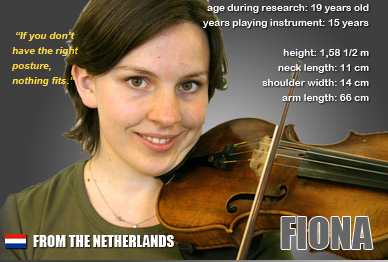4. What worked for me
Going through changes
During the research year I went through a lot of changes in my equipment and way of playing. The pain that I had had in my right shoulder was slowly going away as we worked on it, but sometimes I started to get “crazy,” to have a feeling of panic.
I think this panic had a physical cause, because I had so much pain. I was thinking “will this never go away?” Sometimes the pain would make me stop playing for a bit, and then my pain would get less but I still wasn’t comfortable. There was always something keeping me from playing as I wished.
When we first made the changes to my chin rest and shoulder rest I was really glad, because it felt so different and I really felt better. But after a while I was changing so much, especially my shoulder rest, that I was absolutely going mental. I thought, if this doesn’t stop, I am going to throw my violin out of the window. It was really driving me mad. But when I found I could play pretty well with the play-on-air shoulder rest, I then I realized I had to stop searching for the perfect thing. I’ve discovered that is very important not to change your equipment all the time if you want to stay sane!
At that point my shoulder was not that stable either. And I believe that when your shoulder is not stable, you can keep looking and changing, but it is not going to get any better. The basic structure is yourself: your body, and your posture. That is really important. If you don’t have the right posture, nothing fits.
Support from other people
So this physical pain and the panic were getting the upper hand for awhile until I got some support from other people. Speaking from experience, you need people around you, whether it is you parents or your brother or your friends -- people that understand. If I had been on my own I would never have been able to do it.
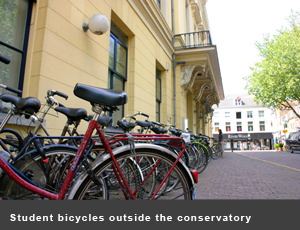
I think it helps if people understand the topic, if they understand why you are feeling weird. That’s why it was also really, really important for me to be in the research group. In the first place you get to know what other people’s frustrations are and you know you are not the only one that has those kinds of problems. You are with people that are going through the same thing so they come up with solutions for you. But the most important thing is that you are not going through this completely on your own. This may sound really dramatic, but it does make a difference! The fact that other people keep finding solutions and keep going makes you think, “OK, actually anyone can do this.”
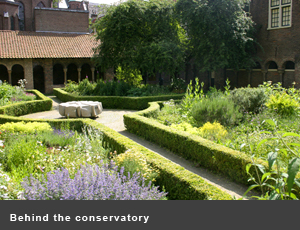
Sometimes I just needed to be told what to do. My violin teacher gave me the play-on-air that ended up working for me. During that time I also had a Mensendieck therapist who made me promise at one point to stop changing my shoulder rest all the time. I had already concluded for myself that it was really important that I just found something that I wouldn’t have to change for a period of time. This gave me more rest for my brain, as I could give myself time to get used to it. This was a good compromise which allowed me to think, “I can play; let’s do it.”
Now I feel I can look into problems more easily myself, because I have heard so many things from different people.
Alexander Technique
I think Alexander Technique gives you some form of rest in your body. It takes away a certain amount of stress that needs to be taken away when you are playing. I also learned that if you over-relax you can’t actually do anything, you can’t play the violin. You just have to learn which muscles to use.
I am more aware of unnecessary tension in my playing. When I am tense I feel I can’t be as flexible in my fingering and position changes, and my vibrato tightens. Tension also affects the way I use my right arm. I am not able to bow as fast, and even my pizzicato it affected. During the research I learned a lot about the relation your neck has to your arms. Before I didn’t know that my arm troubles could be coming from my neck. I was very sceptical about this! These days I know that a pain in my shoulder can come from my neck and back as well.
We learned in the Alexander Technique lessons a lot about how to get space in between the shoulder blades at the back, but also at the front. People always talk about the pain in their back. But they never ever talk about their front. But the front has a tendency to tighten up just as much.
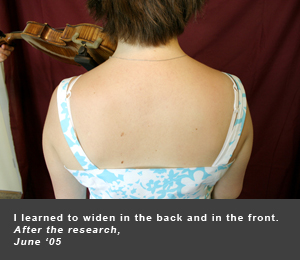
I think the power you need in playing comes from your back; you have to be free in your back. It’s not like the violin is part of some puzzle that fits in to your body and then you’re like all stuck. You need to be comfortable, you need to be able to move your head freely and your neck has to be able to be free. That’s basically it.
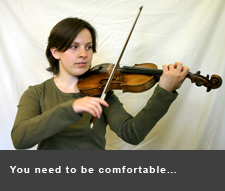
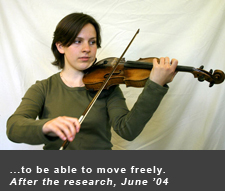
Still, it is difficult. You tend to forget. You tend to say to yourself, “Ah it’s going all right now. It’s not that important anymore.” But I think you have to keep telling yourself that it is important not to forget about how to use your body the right way. It is a kind of discipline that you need. I was just thinking about that again today. It’s just one of the most important things to get somewhere playing the violin. Because if you don’t take care of yourself, sooner or later you are going to get pain somewhere. You’re not going to avoid it, not forever, unless you have this very weird amazing body, which very few people do, I should say.

